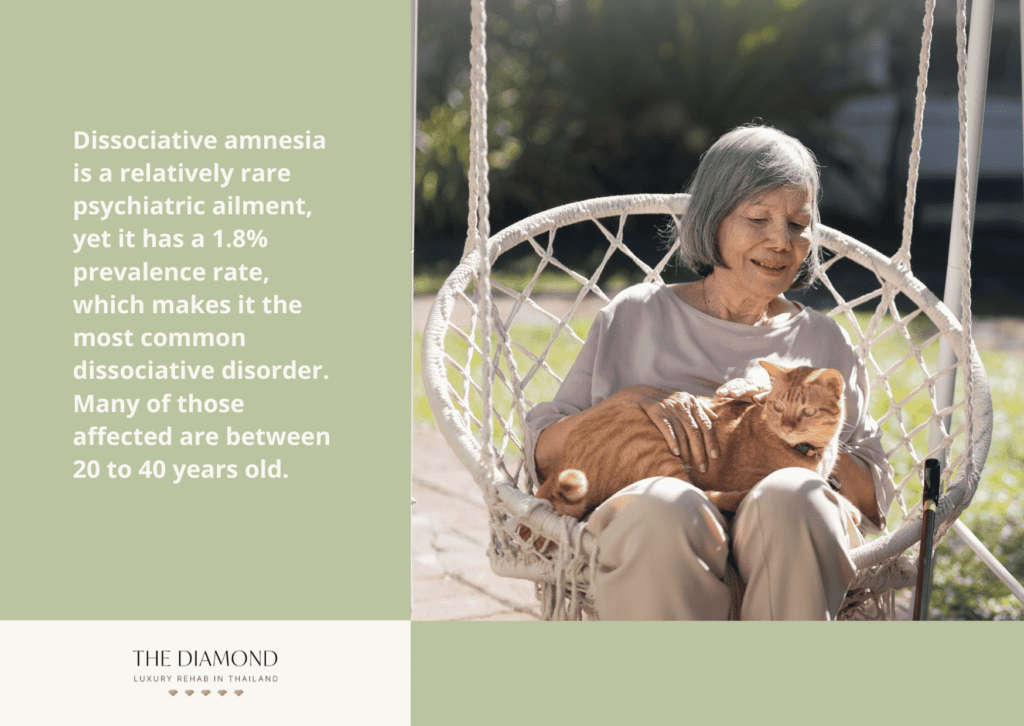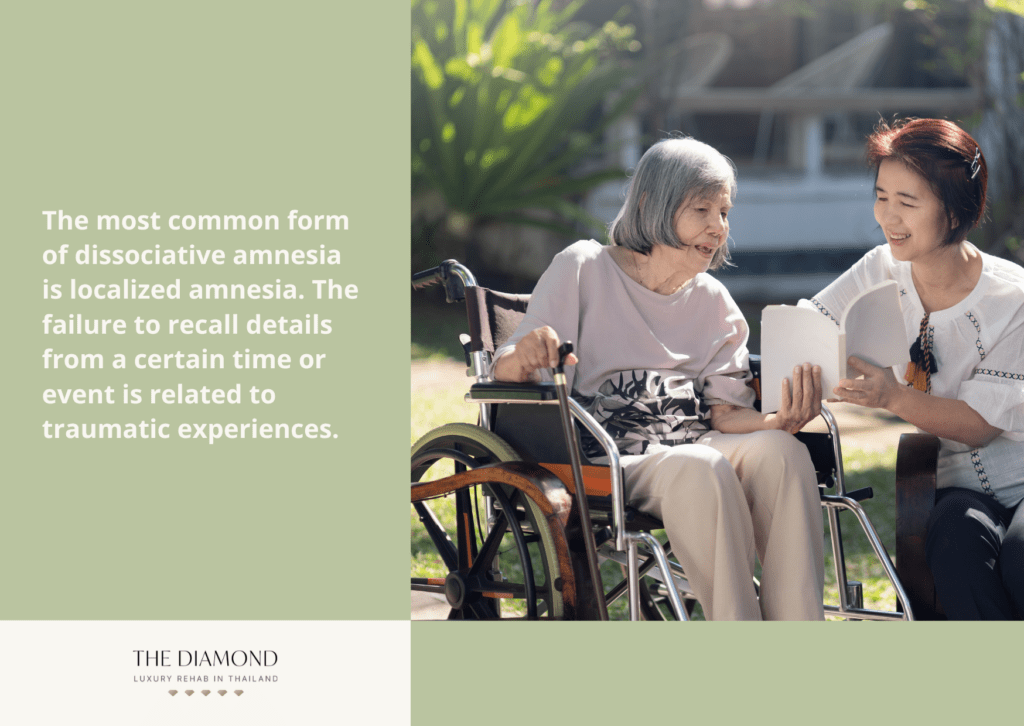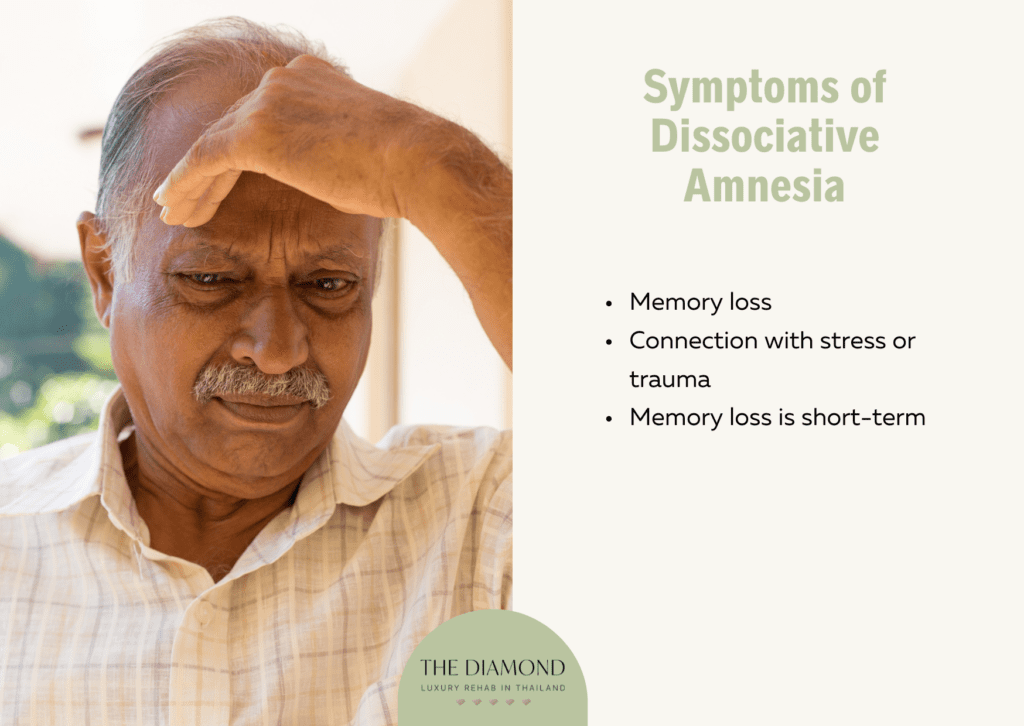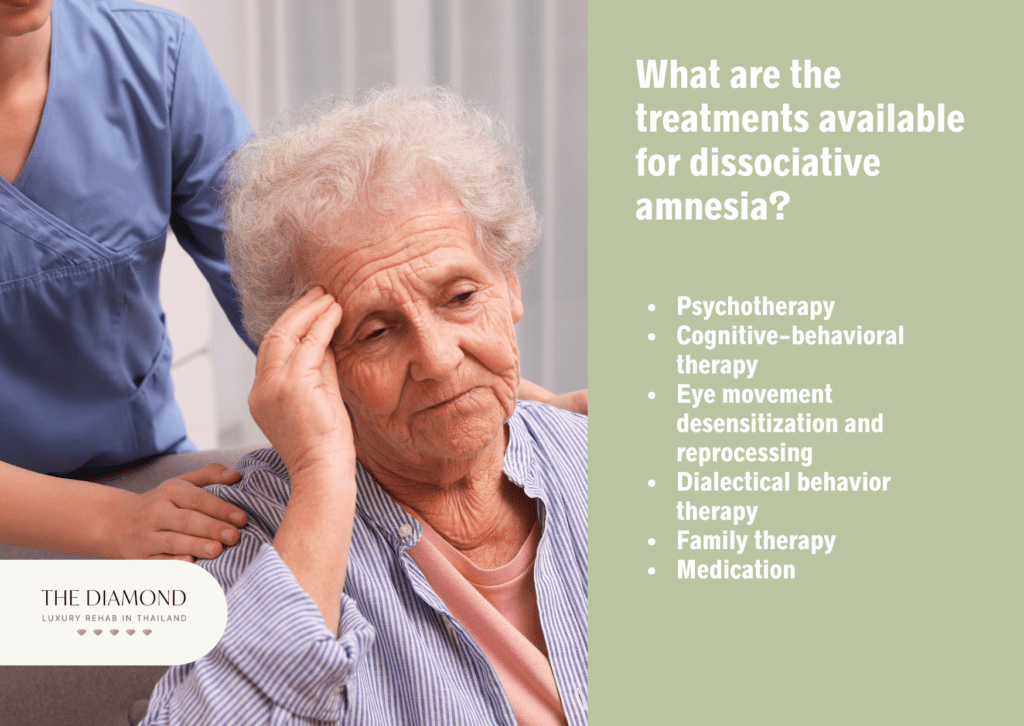Dissociative amnesia: causes, symptoms and treatments
Table of content
- What is dissociative amnesia?
- How common is dissociative amnesia?
- What is the most common dissociative amnesia?
- What are the causes of dissociative amnesia?
- What are the symptoms of dissociative amnesia?
- What effects does dissociative amnesia have on a person’s life?
- What are the risk factors for dissociative amnesia?
- What are the treatments available for dissociative amnesia?
- 1. Psychotherapy
- 2. Cognitive-behavioral therapy
- 3. Eye movement desensitization and reprocessing
- 4. Dialectical behavior therapy
- 5. Family therapy
- 6. Medication

Dissociative amnesia is a type of dissociative disorder that involves memory gaps. It includes a breakdown or disruption in identity, memory, awareness, perception, and consciousness. This forgetting either includes much of the patient’s life or is limited to a specific area or person.
The causes of dissociative amnesia include abuse, neglect, traumatic or stressful events, and problems with past experiences and personal identity.
The symptoms of dissociative amnesia include memory loss. This is the kind of memory loss that’s much more profound than regular forgetfulness and it can’t be explained by a medical illness.
The treatments for dissociative amnesia are psychotherapy, cognitive behavioral therapy, dialectical behavior therapy, eye movement desensitization and reprocessing, family therapy, and medication.
What is dissociative amnesia?
Dissociative amnesia is a memory disorder. A study by Leong et al., published in the January 2006 issue of the peer-reviewed journal Psychiatry (Edgmont) defined dissociative amnesia as a disorder recognized by memory gaps, which involve the inability to remember personal information, typically related to a traumatic or distressing experience.
The Diagnostic and Statistical Manual of Mental Disorders, 5th Edition (DSM-5) by the American Psychiatric Association classifies dissociative amnesia under the dissociative disorders section. The dissociative amnesia definition involves one or more episodes of inability to remember important personal information.
There are different types of dissociative amnesia, such as localized amnesia, selective amnesia, continuous amnesia, generalized amnesia, systematized amnesia, and dissociative fugue.
Dissociative amnesia is a severe form of forgetfulness beyond normal forgetting. It happens in a patient who witnessed or suffered serious trauma. The condition tends to occur alongside other psychiatric conditions, especially personality disorders like dissociative identity disorder.
Dissociative disorder is both a new and an old mental disorder. The history of dissociative amnesia has a notable impact on how the disorder is treated today. Over a century ago, Sigmund Freud and Pierre Janet, influential figures in dynamic psychiatry, were greatly impacted by dissociative experiences, leading them to develop distinct theories about the human mind.
It aided clinicians in comprehending mental illnesses that were previously challenging to diagnose and categorize using standard psychiatry, as per a 2011 review article by Kenichiro Okano published in Seishin Shinkeigaku Zasshi. The term psychogenic amnesia was traditionally meant to describe episodes of retrograde and anterograde memory loss.
However, over the years, experts realized they had to use different categories to capture the impact of amnesic disorders such as dissociative, hysterical, functional, and other amnesic disorders, according to a 2012 study by Angelica Staniloiu and Hans J. Markowitsch in Brain Sciences.
The major difference between dissociative amnesia and retrograde amnesia is that retrograde amnesia is memory loss that happens as a result of a traumatic injury or a serious health complication such as degenerative brain disease, stroke, or seizure.
Dissociative amnesia, on the other hand, has a psychological, instead of a neurological cause. It’s been linked to overwhelming stress due to a serious traumatic event. Stress-induced amnesia happens when a person blocks out particular events. This leaves them unable to recall key personal information.
How common is dissociative amnesia?

Dissociative amnesia is a relatively rare psychiatric ailment, yet it has a 1.8% prevalence rate, which makes it the most common dissociative disorder. Many of those affected are between 20 to 40 years old, according to a 2020 study by Tobechukwu A. Clouden published in Cureus.
The 10th chapter of the book, “Global Emergency of Mental Disorders” published in 2021 by the Academic Press stated that the prevalence of dissociative amnesia is 1% among males and 2.6% among women. There is no known explanation for why Canada and Turkey have such significantly higher rates of dissociative amnesia than the United States, according to a documented epidemiology study which places the lifetime prevalence at 6%–7% in those countries.
However, among psychiatric patients receiving treatment worldwide, the prevalence ranges from 7% to 11%. Memory loss caused by trauma leads to impaired or fragmented memories.
What is the most common dissociative amnesia?

The most common form of dissociative amnesia is localized amnesia. The failure to recall details from a certain time or event is related to traumatic experiences.
A dissociative memory is localized within a specific window of time. However, the patient’s memories remain intact before and after the occurrence. One dissociative amnesia example is when a person survives a car wreck. They have no memory of that experience, until two days later. It means they are experiencing localized amnesia.
This gap in memory tends to stem from extreme stress or a terrifying experience. While generalized amnesia is a rare form of dissociative amnesia, cases such as these are often recorded in patients with profound traumatic experiences such as childhood abuse, sexual abuse, or prolonged mistreatment.
It refers to an acute onset of complete memory loss about the patient’s life history. Those impacted experience a loss of personal identity, semantic knowledge, and procedural knowledge, according to a topic on the Johns Hopkins Psychiatry Guide titled, “Dissociative Amnesia” last updated in May 2017. However, dissociative amnesia statistics are lacking since this disorder is not detected in several patients, and its prevalence is not well-established.
At this point, it is not clear why localized amnesia is more common than other types of dissociative amnesia.
What are the causes of dissociative amnesia?
Causes of dissociative amnesia are related to overwhelming stress, but a combination of different factors play a role in the development of this problem. The causes of dissociative amnesia are listed below.
- Trauma: Experiencing or witnessing any kind of traumatic event leads to dissociative amnesia because a person blocks out certain memories. As a result, they are unable to remember certain important personal information. In other words, experiencing a severe emotional shock creates a serious gap in memory. Blocking out certain events in one’s mind is a coping mechanism or the brain’s attempt to protect itself i.e. it occurs due to the inability to process trauma in a healthier manner. The onset of memory loss from trauma is usually sudden. Dissociative amnesia from trauma is not the same as amnesia from brain damage or brain disease. In patients with medically-caused amnesia, recovering the lost memories is rare or takes a long time. Most patients with amnesia dissociative disorder experience short-term memory loss.
- Genetics: Evidence suggests that genetics play a role in the development of dissociative disorders. For example, a review by Richard J. Loewenstein published in the September 2018 issue of Dialogues in Clinical Neuroscience reported that dissociation has been linked to the interplay between traumatic experiences and particular single nucleotide polymorphisms in genes connected to the hypothalamic-pituitary-adrenal (HPA) axis, serotonergic, dopaminergic, and brain-derived neurotrophic factor (BDNF) systems.
- Brain changes and abnormalities: Traumatic experiences interfere with the brain’s ability to retrieve personal information associated with those events, which further contributes to the development of dissociative amnesia. A 2009 study by Brand et al., from Psychiatry Research found that patients with dissociative amnesia had some functional brain changes. For example, scientists observed a notable reduction in glucose utilization in the right inferolateral prefrontal cortex of the patients. Reduced metabolic activity in this specific brain area, which is associated with recalling personal memories and processing information related to oneself, may reflect a neurological manifestation of dissociative amnesia.
What are the symptoms of dissociative amnesia?

Symptoms of dissociative amnesia vary in severity and duration. The symptoms of dissociative amnesia are listed below.
- Memory loss: This symptom includes forgetting personal information, like your address and name, to blocking particular areas or events that have happened in your life. An individual with trauma-induced amnesia tends to not remember their coworkers, family, and close friends. The symptoms of generalized amnesia cause forgetting everything about life and self. Dissociative amnesia with dissociative fugue leads to symptoms like traveling away from home, confusion, and memory loss. A person is likely to do things without remembering. It feels like being disconnected from their thoughts or sense of self. Patients additionally do not remember where they were born, grew up, or any general information about their background. Furthermore, patients often do not remember how they traveled so far away from their home, explained a 2020 case report by Agenagnew et al., published in Case Reports in Psychiatry.
- Connection with stress or trauma: Dissociative amnesia is often associated with a distinct stressful or traumatic life event like fighting in a war, or witnessing or experiencing physical and sexual abuse. With trauma amnesia, people do not remember information related to the time they went through the trauma. For example, a person can’t remember details from the time when the abuse happened.
- Memory loss is short-term: Various dissociative amnesia (DA) episodes are short-term. They tend to last for a few minutes, hours, to a couple of days. In very rare cases, they last longer. When DA symptoms subside, most patients recover their memories. Memories return suddenly and completely in most cases. It’s possible that therapy or something in a person’s environment triggers memory recovery.
What effects does dissociative amnesia have on a person’s life?
The effects of dissociative amnesia on a person’s life include anxiety, depression, and confusion. According to a 2014 review titled, “Dissociative amnesia” from Lancet Psychiatry, dissociative amnesia is marked by functional impairment.
Certain people with dissociative amnesia have difficulties taking care of themselves or doing everyday activities such as getting out of bed, grooming, dressing, etc. It significantly interferes with their work activities, and social, and romantic relationships.
As a result, affected individuals have an increased suicide risk. However, the impact of the disorder varies depending on the causes of dissociative amnesia. When someone experiences traumatic memory loss, that short-term memory loss after trauma comes back.
Frequently, DA patients relive their trauma through intrusive, involuntary recollections. In addition, recalling the trauma voluntarily (strategically) is challenging and critical details are entirely or partially inaccessible.
Patients with PTSD (post-traumatic stress disorder) have these characteristics as well, as per a 2014 study by Dorthe Berntsen and David C. Rubin in Clinical Psychological Science. In fact, memory loss and PTSD go hand in hand. When triggered by trauma, PTSD overwhelms someone’s ability to cope. This is associated with full or partial memory loss.
The complex link between amnesia, dissociative disorder and PTSD causes profound stress and anxiety for patients who experience both debilitating and frightening conditions.
What are the risk factors for dissociative amnesia?
Risk factors for dissociative amnesia include a variety of psychological, environmental, and biological factors that heighten an individual’s vulnerability to this illness. The risk factors for dissociative amnesia are listed below.
- Sexual, emotional, or physical abuse or assault
- History of previous emotional trauma
- Prolonged trauma or mistreatment
- Witnessing natural disasters such as tornadoes, floods, earthquakes
- Receiving physical threats
- Participating or witnessing military and war-related activities
- Experiencing or witnessing horrible accidents
- Growing up in an unsafe, dysfunctional environment
- History of mental illness including sleep disorders, personality disorders, depression, PTSD, and anxiety disorders
- Having dissociative identity disorder (DID)
How is dissociative amnesia diagnosed?
Dissociative amnesia is diagnosed by first conducting a physical exam. The goal is to rule out any other potential causes like alcohol, drug abuse, brain injury, or illness. Although there isn’t a specific dissociative amnesia test, the doctor is going to suggest imaging or blood tests.
If there isn’t a physical cause for the amnesia, then the doctor refers a patient to a mental health expert such as a psychiatrist or psychologist. To evaluate the amnesia trauma, the mental health specialist does a psychological exam. They collect different information about a patient’s past experiences.
They ask about a patient’s symptoms, emotions, thoughts, and behaviors. After the psychological exam, the specialist uses other tools to get a proper diagnosis such as the Diagnostic and Statistical Manual of Mental Disorders (DSM-5), or a screening dissociation test for dissociative identity disorder.
The screening test is a questionnaire consisting of multiple questions about daily life and experiences. When answering, a patient needs to determine the level at which the experience described applies to them.
What are the treatments available for dissociative amnesia?

Treatments available for dissociative amnesia are designed to treat trauma and symptoms like memory loss. The treatments available for dissociative amnesia are listed below.
- Psychotherapy
- Cognitive-behavioral therapy
- Eye movement desensitization and reprocessing
- Dialectical behavior therapy
- Family therapy
- Medication
1. Psychotherapy
Psychotherapy or talk therapy is a key treatment for dissociative amnesia, according to a 2020 paper by Subramanyam et al., published in the Indian Journal of Psychiatry. It helps treat a wide range of emotional troubles and mental illnesses. This psychogenic amnesia treatment manages troubling symptoms so that the patient functions better and improves their well-being.
What makes this one of the most popular treatments for dissociative identity disorder and amnesia is that it helps cope with the impact of trauma, daily life, anxiety, depression, or other mental disorders.
2. Cognitive-behavioral therapy
Cognitive-behavioral therapy (CBT) treats a variety of psychological conditions as well as dissociative traumatic amnesia. Cognitive therapists help patients develop different coping skills, all of which aid them in overcoming and managing the experience.
CBT focuses on addressing negative behavior and thinking that stem from a stressful and traumatic event. This helps patients overcome the issues surrounding the loss of memory due to trauma.
Through cognitive behavioral therapy, patients replace and challenge distorted thoughts with constructive thoughts. They additionally change the way they behave to a certain trigger. People are able to get a better understanding of their dissociative behavior and take the necessary steps to change it through this approach.
3. Eye movement desensitization and reprocessing
Eye movement desensitization and reprocessing (EMDR) is an individual therapy treatment that takes on a different approach than other treatments for dissociative disorders. Instead of focusing on altering the thoughts, feelings, and responses that result from a traumatic event, EMDR therapy focuses on the memory itself.
The goal of EMDR therapy is to change the way the mind stores that memory thereby removing or decreasing the problematic symptoms. Managing trauma memory loss takes a certain amount of time. However, this type of treatment is usually delivered 1 to 2 times a week for a total of 6 to 12 sessions.
4. Dialectical behavior therapy
Dialectical behavior therapy (DBT) is a type of psychotherapy for patients who experience very intense emotions. It is a modified type of CBT. To help people overcome memory loss trauma, a DBT program teaches them healthy ways to cope with stress.
Patients learn how to live in the moment, manage their emotions, and work on their relationships. The DBT program is meant to treat borderline personality disorder (BPD). However, it is a viable therapy for dissociative identity disorder, eating disorders, and mood disorders as well.
When it comes to trauma-induced memory loss, this therapy helps patients accept and understand their difficult emotions. It aids them in acquiring proper skills to manage these negative feelings and make positive changes in their lives.
5. Family therapy
When dissociative amnesia treatment has to take on a different approach, that’s where family therapy comes in handy. This treatment aims to educate the family about the symptoms and causes of dissociative amnesia disorder.
Both the patient and their family are able to use this therapy to build empathy as well as reduce conflict, and establish healthy boundaries, communication, and problem-solving skills. The patient must come home to a safe and positive environment. Otherwise, it hinders their clinical progress.
6. Medication
There is no medication for dissociative amnesia. However, patients with dissociative complications or dissociative amnesia disorder typically suffer from anxiety and depression, too. Anti-anxiety medications or antidepressants help with that.
When used for PTSD, medications like SSRIs and SNRIs decrease PTSD symptoms. The most commonly recommended options include Sertraline, Venlafaxine, and Paroxetine. They help ease the symptoms of patients with amnesia PTSD.
For medical dissociative identity disorder treatment, doctors offer psychiatric medication. Options like mood stabilizers and antipsychotics help control the behavior of different identities.


